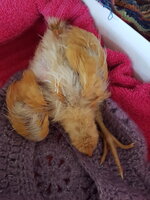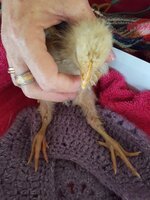Jan Aucamp
Chirping
Dear Extended Family
After many a disappointment and obstacle, I finally managed to hatch 15 Orpington Buffs from a make-shift incubator. Which is something completely different...thank you Monty Python!
Mozambique is part of the dark continent, no lies. Herewith the problem to you, Oh Extended Family.
First some background:
The rest of the flock is pretty good. No signs of distress.
There are 5 other adults ruling the yard with one hen having laid her 7th egg this morning. The two other pullets are running around with two gorgeous roosters. They don't know what's going to happen to them in another two weeks.
I attach two photographs taken after 12 hours.
Dear Family, please help.
Regards
Jan Aucamp (In my home language Afrikaans, that would be the equivalent of John)
After many a disappointment and obstacle, I finally managed to hatch 15 Orpington Buffs from a make-shift incubator. Which is something completely different...thank you Monty Python!
Mozambique is part of the dark continent, no lies. Herewith the problem to you, Oh Extended Family.
First some background:
- Locality: Mozambique, East Africa
- Place: An old farm house on an even older farm house.
- Climate now: Warm, very dry and windy.
- 15 Chicks hatched from 26 eggs smuggled into Mozambique from South Africa (again).
- Chicken breed: Orpington Buff.
- 6 Embryo deaths.
- 5 Eggs were not fertilized...or something.
- Incubator temperature control between 37.2°C and 38.0°C.
- Humidity: good to perfect.
- 1 mortality 2 days after hatching.
- Age today: 21 days.
- Inoculations: On day 5 inoculated against Newcastle disease. Not inoculated against Gumboro (yet) or Mareks disease. Mareks is not known in Quelimane, Mozambique. Even the local vet never heard of that.
- Food: Good food from Higest bought locally.
- The chicks sleep warm at night and are outside on green grass and sandy soil during the day.
- The water that they drink is from a well. The water is not clear due to suspended solids. We use it for washing, showering and cleaning but not for drinking. I actually have never drunk the water in large quantities. I am a geologist; I prefer beer. It tastes good enough; the water. The beer is excellent though. The water was never analysed for E coli etc. Having said that, my gorgeous Scottish wife did contract a nasty fungal infection in the urinary tract. Now that cost a lot of money...another story.
- Yesterday afternoon I noticed a chick that tried to crawl in underneath the other birds. He appeared distressed and being able to walk properly with little control over its legs.
- I removed the bird from the flock and placed immediately in the care of the Scottish lass.
- The chick (not the lass) was hot; it had a high temperature.
- Water with vitamins (the whole B-series and riboflavin, niacin and the like) administered with a syringe.
- About three hours later, it was fed with a high protein cereal (locally know as Pro-Nutro).
- It became calm and its temperature dropped.
- The Scott made sure it was warm and cushy throughout the night.
- 12 Hours later the bird was still alive but now with almost no control over its legs.
- It was kept alive until now (roughly 24 hours) with medicated water and the cereal. It did attempt to eat on its own but with not much success.
The rest of the flock is pretty good. No signs of distress.
There are 5 other adults ruling the yard with one hen having laid her 7th egg this morning. The two other pullets are running around with two gorgeous roosters. They don't know what's going to happen to them in another two weeks.
I attach two photographs taken after 12 hours.
Dear Family, please help.
Regards
Jan Aucamp (In my home language Afrikaans, that would be the equivalent of John)


